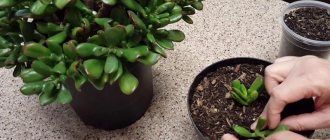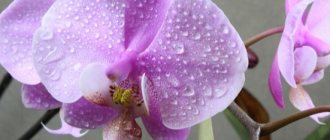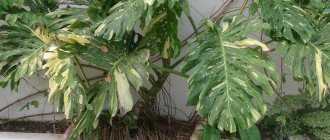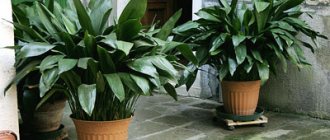When the discoverers, setting foot on the American coast, saw giant trees with slits in their leaves, they called the discovery “monsters.” Foreigners experienced particular fear when observing such a characteristic monstera phenomenon as aerial roots. Forming along the entire length of the trunk, the root, having reached the ground, took root there to continue development. Some roots appeared at great heights and continued to develop, reaching any support that stood in their way. Almost the same thing happens in the apartment.
Description of the plant
Monstera is an evergreen tropical crop of the genus Liana of the Araceae family, whose homeland is considered to be the southern regions of America. It has large, massive leaves in the shape of a heart with slits, the color of which is rich green, and may have spots, stripes of a lighter or yellow shade. Young leaves are devoid of slits: only with a certain age do they develop holes, which later transform into long slits.
The plant has a long stem from which roots can hang down. Under natural conditions, the height of an adult plant can reach 6 m, in domestic conditions - 4 m. It blooms in the form of a beige cob. After flowering is completed, it forms a fruit - a berry that is suitable for food. There are about thirty species of monstera in the world. In most cases, only a few are grown at home: monstera charma, lopsided or perforated.
Did you know? Many people mistakenly believe that the word “monstera” is translated as “monster, monster.” However, in fact, from Latin “monstrum” means “amazing, bizarre.”
Process
This method of monstera propagation is applicable if the plant has lateral shoots. In this case, they are carefully cut off and placed first in a container with water for several days. As a rule, by the time of cutting they already have root primordia; all that remains is to wait until the root system grows a little. This takes several days. Afterwards the plant is planted in a pot.
Another way:
- there is a lateral shoot with the strongest aerial roots;
- the place with the roots is wrapped in damp moss;
- wrap the top with cling film or a plastic bag, not tightly;
- this whole structure is secured, perhaps with tape, creating a kind of greenhouse effect;
- Then comes the waiting period.
Attention: the shoot is not cut off immediately from the main trunk, it receives all the necessary nutrients, and only when roots appear and develop can it be cut off and transplanted into a separate container.
A monstera planted in this way will not be lush and branchy; it will tend to grow upward; in the photo below there is a monstera planted precisely from a lateral shoot.
Basic growing rules
Despite its exotic origin, monstera is quite easy to grow and unpretentious to care for. However, for healthy growth it requires compliance with certain conditions:
- Lighting. A tropical guest needs to provide bright, but not direct lighting. She is equally negative about shadows and direct UV rays. In the first variant, its leaves stop developing and do not form slits; in the second, they dry out and become covered with yellow spots. In winter, it is recommended to install artificial light sources to provide the required amount of light.
- Temperature conditions. Since the plant comes from the tropics, it prefers to grow in a warm microclimate with a temperature range of +22–25 °C in summer and +17–22 °C in winter. It is strictly forbidden to keep the vine in drafts.
- Watering. The flower needs frequent and abundant watering, especially in spring and summer, when the phase of intensive development begins. It is also recommended to spray the leaves with water or wipe with a damp cloth weekly.
- The soil. The soil mixture for the decorative crop in question should consist of the following components: peat and turf soil, humus and river sand. A drainage layer is required.
- Feeding. Like any decorative flower, monstera needs systematic feeding, which is excellently provided by mineral fertilizers and organic compounds intended for lianas. It is imperative to feed the tropical vine between March and August, when active growth is observed.
- Trimming. It is not a mandatory procedure when growing a tropical beauty. To form beautiful lush forms, it is enough to cut off the top of a young plant at the initial stage of its growth, which, in order to avoid infection, should be treated with charcoal.
When can a plant be replanted?
A young monstera, up to 3–4 years old, requires an annual transplant. Next, you should replant the plant by age:
Recommended reading
How to properly plant indoor flowers in a pot
- 3–4 years - once every 2 years;
- over 5 years - every 3-4 years, subject to annual replacement of the top part of the soil.
Regular replanting of the plant allows you to maintain its health and stimulate growth.
For a tropical flower, you should select a pot whose depth corresponds to the size of the rhizome, and the width allows the lateral roots growing from the stem to subsequently take root freely in the soil. The material from which the container for the flowerpot is made does not matter much.
Beware of pests!
The plant may be endangered by the following pests:
- Scale insects . How to identify: leaves dry out and fall off. What happens: insects suck out cell sap. How to fight: wipe the leaves with a soapy sponge and treat with actellik solution.
- Spider mite . How to detect: cobwebs in internodes, leaves falling off. How to fight: since the appearance of mites is usually caused by excessive dry air, the main method of control is to moisten the leaves by spraying. The first thing you need to do is wash them with a soapy sponge and rinse under warm running water. In particularly severe cases, you can treat with Actellik solution.
- Thrips . How to identify: the appearance of light dots on the outside of the leaf. How to fight: again, treatment with Actellik solution will be effective.
- Mealybugs . How to identify: leaves shrivel, dry out and fall off. How to fight: wash with a soapy sponge, rinse the leaves in a warm shower and regularly spray with plain water. In case of severe damage, you can again resort to the help of actellik.
In the wild...
That's all you need to know to grow a beautiful monstera from a small root. Go for it!
Soil composition requirements
Under comfortable conditions, monsteras grow quite quickly. For planting, a light fertile soil mixture is used, the composition of which varies slightly depending on the age of the plant. For young vines, the following soils are used in equal quantities: turf and peat soils, humus and river sand. In this case, the recommended acidity (pH) should be 5.5–6.0.
Important! One of the main conditions when choosing a pot for a monstera is its stability. It is better to choose durable, fairly weighty containers that will not tip over from the weight of the leaves and stem.
To transplant adult monsteras, the following soil composition should be used:
- turf soil - 3 units;
- peat soil - 1 unit;
- deciduous soil - 1 unit;
- river sand - 1 unit;
- humus - 1 unit.
The acidity of the soil mixture should be 6.5–7.0.
How to properly transplant a monstera at home
As mentioned above, in the comfortable conditions of the house, Monstera intensively develops, grows, and after a few months requires transplantation. This activity is recommended to be carried out in the first weeks of spring, before the active growth phase has started.
Did you know? People in Asian countries believe that Monstera has medicinal qualities. So, for example, in Thailand, this plant is always placed near the beds of seriously ill patients so that it absorbs negative energy and promotes a speedy recovery.
Before transplanting the vine into another pot, you should prepare a new container, the size of which should differ from the previous one by 7–10 cm. A drainage layer must be laid on the bottom using expanded clay or ordinary pebbles. It is recommended to follow the following algorithm:
- Use a knife to carefully “cut” the soil around the entire perimeter of the pot so as not to touch the roots;
- pull out the support and set it aside;
- carefully shake out the soil from the rhizome, clean the roots with your hands, remove some of the old soil;
- place the support, along with the leaves and stems of the plant, firmly in the pot, and at the same time place the roots in the container;
- cover with soil, water thoroughly;
- After the soil settles under the influence of moisture, add a little more soil to the pots.
Video: how to properly transplant a monstera at home
The transplanted plant must be moved to a spacious and well-lit room. During the replanting process, there is no need to remove aerial roots - it is recommended to tie them up so that they look down, then they can take root in the ground. The replanting process, as a rule, does not cause any particular difficulties, but is sometimes complicated by the presence of a large number of aerial roots.
To transplant a young plant with them, you will need:
- cut off a leaf with a stem or a whole branch with shoots;
- place them in a container with clean water;
- monitor when the shoot sprouts additional roots;
- prepare the necessary pot, add drainage and soil;
- plant the flower in a flowerpot and water it generously.
Reproduction methods
Growing from seeds
The sown monstera seeds are placed in a warm and well-lit place. The first seedlings should appear within 30 days. The first leaf blades are juvenile and have no slits. The first adult foliage appears at 5–8 months. After 2 years, the bush will have no more than four adult leaf blades and up to 5 juvenile ones. The seedlings are first planted in individual pots, and then they are replanted every year.
Cuttings
Cuttings are carried out throughout spring until early summer. Monstera can be propagated by stem or apical cuttings, as well as by lateral shoots. A cutting is a piece of stem with 1–2 leaf blades. The cut areas are treated with charcoal powder. For rooting, the cuttings are planted in a separate pot, and the top is covered with glass. At the bottom you need to make a drainage layer from pieces of brick, cover it with a two-centimeter layer of peat or humus soil, and then pour 20–30 mm of sand. Watering is carried out regularly in the morning and evening, and the air temperature should be 20–25 degrees. After the cuttings grow roots, they are planted in an intermediate pot. After 3 or 4 years, the overgrown bush is transplanted into a tub or larger pot. In order for the cutting to take root faster, you need to choose one that has aerial roots.
Monstera. Rooting monstera cuttings.
Reproduction by apex
Old bushes lose their decorative value because their lower leaf plates fly off. In this regard, you can wrap the 2 upper aerial roots with moistened moss or twine and fix them on the trunk of the flower. After the roots grow, cut off part of the trunk with 1-2 leaf blades, and treat the cut area with charcoal powder. Plant the cutting in a pot, while covering the roots and the cut area with substrate. The old bush should also send out side shoots, and it will become more lush.
Care after transplant
The transplanted plant does not require special care, but in order for its “transportation” to be the least painful, it is recommended to follow a few simple rules.
Important! In cramped conditions, the monstera can wither and even die.
Watering and fertilizing
When the plant is already in a new pot, it needs to be provided with high-quality fertilizing, which will allow it to quickly adapt and fully nourish the root system. Since transplantation is a kind of stress for a tropical flower, experts recommend closely monitoring its condition during the first week. It is necessary to water the plant quite often, as the soil dries out, but do not allow it to form a swamp on the surface of the soil.
Pruning and shaping monstera
After replanting, a young plant does not need pruning or crown formation. But in an adult, it is recommended to cut off the top - this will speed up the growth of lateral stems and make the plant more voluminous.
Seeds
In short, this is the least common method. Not popular due to ineffectiveness. You have to put in too much effort, wait a long time (on average, two years), and whether you will get a positive result in the end is unknown. If the seeds do germinate, then after a while they are picked, planted in pots and then cared for like any monstera.
Possible difficulties of cultivation
Monstera, fortunately, has good resistance to various pests and gets sick in rare cases. Basically, all its diseases are associated with unfavorable living conditions, in particular, disturbed microclimate, lack of nutrition or excessive watering.
Did you know? The tropical beauty can act as a barometer. Before a thunderstorm or rain begins, its leaves begin to “cry”, forming small droplets of water on the surface.
The fact that a flower is affected by any pests or diseases can be determined by its appearance:
- Light spots on the leaves , which gradually fill the entire surface and later become gray, indicate damage by thrips - microscopic parasites that are not visible to the human eye. Treating greens with insecticides helps control pests.
- Significant loss of foliage may indicate an infestation with spider mites, which occur at very low indoor humidity. To get rid of the parasite, the foliage of the plant is wiped with a soapy solution and then treated with insecticides.
- Yellowing of the foliage and the appearance of rot on it. Such signs are evidence of excessive waterlogging. To save the monstera, you should adjust (temporarily reduce) watering.
- Pale foliage is considered a sign of a lack of complex mineral nutrition.
- The leaves begin to become lethargic, lifeless, first hang down and then fall off, which indicates infection with scale insects - small insects belonging to the order of coccids. To combat parasites, soapy water is used, which is used to treat each leaf. Next, the foliage is sprayed with insecticides.
- The edges of the leaves curling upward and their color changing to brown may indicate that the plant does not have enough light and sufficient moisture.
- The absence of “cuts” on new leaves may be a consequence of lack of nutrition and feeding.
Despite the impressive size of this amazing tropical plant, Monstera will not cause much trouble when caring for and growing. On the contrary, under good favorable living conditions, the vine can bring invaluable benefits to its owner, because it is believed that the plant enriches the air with oxygen, cleanses it of dust and dirt, absorbs harmful fumes, and also has amazing healing properties - calms the nerves, eliminates headaches, normalizes functioning of the cardiovascular system.
Possible problems
If you do not care for the monstera correctly or do not provide it with optimal conditions for growth, then problems may arise with it.
- Leaves fall . If the lighting is too poor, then the plant begins to shed its leaves, and its growth also stops.
- Spots on foliage . Brown spots may appear on the underside of the leaf blades if spider mites have settled on the bush.
- Yellowing of leaves . The foliage turns yellow if the monstera feels a lack of nutrients. Also, the foliage may turn yellow, and rot may also appear on it due to regular stagnation of liquid in the substrate.
- The foliage turns brown . The leaf blades turn brown and become papery if the air humidity level is too low or when the flower is very crowded in the pot.
- The color of young leaf blades is pale . If the lighting is too intense, then faded leaves appear on the bush, and yellow spots may also form on their surface.
- The bush stretches out . If the monstera does not have enough light, then its shoots become elongated, the stem twists, and new leaf plates grow faded and small.
- Whole foliage . There may be no slits on young leaf blades due to the fact that the flower feels a lack of light or nutrients.
- The foliage dries up and flies away . If the leaf blade turns brown and dries out before falling, this means that the room is very hot. The foliage also falls off as it ages, but in this case it does not turn brown.
- Harmful insects . Most often, aphids, scale insects and spider mites settle on the monstera.











